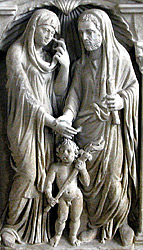
nupta

The word for bride in Latin, nupta, comes from the verb
nubo, which means to cover or veil, and is commonly used in reference to
a woman's marriage to a man. A mark of modesty and virtue, the bride is always
portrayed with her head veiled,
looking with lowered eyes toward her husband at the joining of right hands (see
the moment of iunctio
dextrarum) during the
ceremony (see
options for
the wedding ritual). Catullus lyrically captures the words and spirit of the
event in his epithalamium or wedding song, Carmina
61. A
marriage
contract which reflects the responsibilities of both partners has been preserved
from 1st century BCE Roman Egypt.
Umbricius decries the corruption of the
young married woman, perceiving the messages and gifts brought to her from a
lover by a go-between to be a violation of the sacred marriage bond. His
condemnation is in total opposition to the treatment of this theme of
adulterous dalliance in Latin love poetry.
